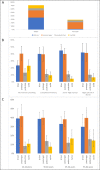Individual characteristics associated with road traffic collisions and healthcare seeking in low- and middle-income countries and territories
- PMID: 38241424
- PMCID: PMC10798533
- DOI: 10.1371/journal.pgph.0002768
Individual characteristics associated with road traffic collisions and healthcare seeking in low- and middle-income countries and territories
Abstract
Incidence of road traffic collisions (RTCs), types of users involved, and healthcare requirement afterwards are essential information for efficient policy making. We analysed individual-level data from nationally representative surveys conducted in low- or middle-income countries (LMICs) between 2008-2019. We describe the weighted incidence of non-fatal RTC in the past 12 months, type of road user involved, and incidence of traffic injuries requiring medical attention. Multivariable logistic regressions were done to evaluate associated sociodemographic and economic characteristics, and alcohol use. Data were included from 90,790 individuals from 15 countries or territories. The non-fatal RTC incidence in participants aged 24-65 years was 5.2% (95% CI: 4.6-5.9), with significant differences dependent on country income status. Drivers, passengers, pedestrians and cyclists composed 37.2%, 40.3%, 11.3% and 11.2% of RTCs, respectively. The distribution of road user type varied with country income status, with divers increasing and cyclists decreasing with increasing country income status. Type of road users involved in RTCs also varied by the age and sex of the person involved, with a greater proportion of males than females involved as drivers, and a reverse pattern for pedestrians. In multivariable analysis, RTC incidence was associated with younger age, male sex, being single, and having achieved higher levels of education; there was no association with alcohol use. In a sensitivity analysis including respondents aged 18-64 years, results were similar, however, there was an association of RTC incidence with alcohol use. The incidence of injuries requiring medical attention was 1.8% (1.6-2.1). In multivariable analyses, requiring medical attention was associated with younger age, male sex, and higher wealth quintile. We found remarkable heterogeneity in RTC incidence, the type of road users involved, and the requirement for medical attention after injuries depending on country income status and socio-demographic characteristics. Targeted data-informed approaches are needed to prevent and manage RTCs.
Copyright: © 2024 Ghalichi et al. This is an open access article distributed under the terms of the Creative Commons Attribution License, which permits unrestricted use, distribution, and reproduction in any medium, provided the original author and source are credited.
Conflict of interest statement
I have read the journal’s policy and the authors of this manuscript have the following competing interests: LAW is employed by WHO; the material included in this article reflects the views of individuals and not necessarily the views of WHO. DGP provides scientific consultations through Epidemiologic Research & Methods, LLC (ERM); none of her consulting through ERM is related to the topic of the current study. Other authors declare no competing interests.
Figures



Similar articles
-
Unintentional Injuries Requiring Medical Attention in Low-Income and Middle-Income Countries: Evidence from Nationally Representative surveys in 12 Countries.J Epidemiol Glob Health. 2025 Jun 10;15(1):82. doi: 10.1007/s44197-025-00420-y. J Epidemiol Glob Health. 2025. PMID: 40493309 Free PMC article.
-
Road accident fatality risks for "vulnerable" versus "protected" road users in northern Ghana.Traffic Inj Prev. 2017 Oct 3;18(7):736-743. doi: 10.1080/15389588.2017.1302083. Epub 2017 Mar 15. Traffic Inj Prev. 2017. PMID: 28296466 Review.
-
Road traffic collisions in Malawi: Trends and patterns of mortality on scene.Malawi Med J. 2017 Dec;29(4):301-305. doi: 10.4314/mmj.v29i4.4. Malawi Med J. 2017. PMID: 29963284 Free PMC article.
-
Incidence and severity of head and neck injuries in victims of road traffic crashes: In an economically developed country.Int Emerg Nurs. 2009 Jan;17(1):52-9. doi: 10.1016/j.ienj.2008.07.007. Epub 2008 Sep 12. Int Emerg Nurs. 2009. PMID: 19135016
-
International trends in alcohol and drug use among vehicle drivers.Forensic Sci Rev. 2016 Jan;28(1):37-66. Forensic Sci Rev. 2016. PMID: 26841722 Review.
Cited by
-
Unintentional Injuries Requiring Medical Attention in Low-Income and Middle-Income Countries: Evidence from Nationally Representative surveys in 12 Countries.J Epidemiol Glob Health. 2025 Jun 10;15(1):82. doi: 10.1007/s44197-025-00420-y. J Epidemiol Glob Health. 2025. PMID: 40493309 Free PMC article.
References
-
- World Health Organization. Global status report on road safety 2018. 2018.
Grants and funding
LinkOut - more resources
Full Text Sources
Miscellaneous
